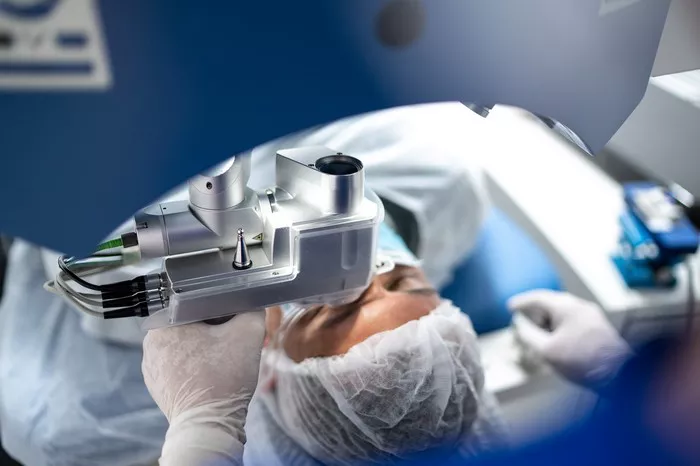Lens replacement surgery, often known as cataract surgery or refractive lens exchange, is a common procedure in ophthalmology. It involves removing the eye’s natural lens and replacing it with an artificial intraocular lens (IOL). This article will explore the cost factors associated with this procedure, providing an objective and professional overview.
Understanding Lens Replacement Surgery
What is Lens Replacement Surgery?
Lens replacement surgery is a medical procedure to treat cataracts or correct refractive errors. The natural lens of the eye is removed and replaced with an artificial lens. This surgery improves vision by allowing light to be properly focused onto the retina.
Types of Lens Replacement Surgery
There are two primary types of lens replacement surgery:
Cataract Surgery: Performed to remove a cloudy lens (cataract) that impairs vision.
Refractive Lens Exchange (RLE): Performed to correct refractive errors such as myopia, hyperopia, and presbyopia.
Cost Factors of Lens Replacement Surgery
Geographic Location
The cost of lens replacement surgery varies significantly based on geographic location. Surgery in urban areas or regions with a high cost of living tends to be more expensive than in rural areas.
Type of Intraocular Lens (IOL)
The type of IOL used in the surgery affects the cost. Standard monofocal lenses are less expensive, while premium lenses like multifocal or toric lenses, which correct astigmatism, are more costly.
Surgeon’s Experience and Reputation
Highly experienced and reputable surgeons may charge more for their services. Their expertise can lead to better outcomes and reduced risk of complications.
Facility Fees
The cost of using the surgical facility, including operating room charges and postoperative care, contributes to the overall expense. Hospitals may charge more compared to outpatient surgery centers.
Preoperative and Postoperative Care
Comprehensive preoperative evaluations and postoperative follow-up visits are necessary for successful surgery. These consultations add to the total cost of the procedure.
See Also: 5 Types of Surgeries to Replace the Lens
Detailed Cost Breakdown
United States
In the United States, the cost of cataract surgery can range from $3,000 to $5,000 per eye. This includes the surgeon’s fee, facility fee, anesthesia, and the cost of a standard monofocal IOL. Premium IOLs can add $1,500 to $3,000 per eye.
Europe
In Europe, the cost varies by country. For example, in the UK, private cataract surgery costs between £2,000 and £4,000 per eye. In Germany, it ranges from €2,500 to €4,500 per eye.
Asia
In Asian countries, the cost can be lower. In India, cataract surgery may cost between $500 and $1,500 per eye, depending on the type of lens and the facility. In Singapore, the cost ranges from SGD 3,000 to SGD 5,000 per eye.
Australia
In Australia, cataract surgery typically costs between AUD 3,000 and AUD 5,000 per eye, with additional costs for premium lenses.
Insurance and Financing Options
Health Insurance Coverage
Many health insurance plans cover the cost of cataract surgery, including Medicare in the United States. However, coverage for premium IOLs and RLE may be limited or not covered.
Out-of-Pocket Expenses
Patients without insurance or those opting for premium lenses must consider out-of-pocket expenses. Payment plans and medical financing options are available to manage these costs.
Government Programs and Subsidies
In some countries, government programs and subsidies can reduce the cost of cataract surgery for eligible patients. It’s essential to check with local health authorities for available assistance.
Choosing the Right Surgeon and Facility
Research and Recommendations
Choosing a qualified surgeon is crucial for successful outcomes. Patients should research potential surgeons, read reviews, and seek recommendations from primary care doctors or optometrists.
Consultation and Evaluation
A thorough consultation and evaluation with the chosen surgeon help determine the appropriate type of IOL and address any concerns. This initial visit is also an opportunity to discuss the total cost and available payment options.
Risks and Considerations
Potential Complications
As with any surgery, lens replacement carries risks, including infection, inflammation, and vision problems. Understanding these risks and discussing them with the surgeon is essential.
Recovery and Follow-Up
Proper postoperative care is vital for recovery. Patients must attend all follow-up appointments and adhere to prescribed eye drops and medications to ensure healing and prevent complications.
Conclusion
Lens replacement surgery is a valuable procedure for improving vision and quality of life. The cost of the surgery varies based on geographic location, type of IOL, surgeon’s experience, and facility fees. Understanding these factors helps patients make informed decisions and plan for the financial aspects of the surgery. Consulting with a qualified ophthalmologist and exploring insurance and financing options can ease the financial burden and ensure successful surgical outcomes.
Related topics:

